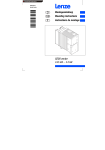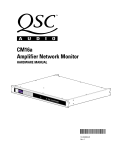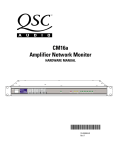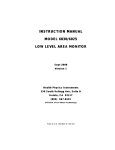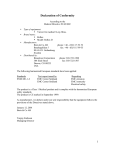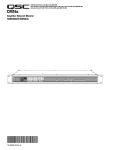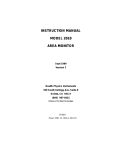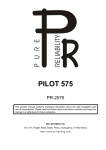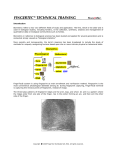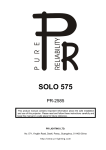Download 6012 MAN VS2.XX - Far West Technology, Inc.
Transcript
INSTRUCTION MANUAL MODEL 6012 DIGITAL DISPLAY \ CONTROLLER July 2003 Version 1a For software V 2.01 X.XX Display Health Physics Instruments 330 South Kellogg Ave, Suite D Goleta, CA 93117 (805) 964964- 3615 FAX: (805) 964 3162 Email: [email protected] www.fwt.com Division of Far West Technology MODEL 6012 INSTRUCTION MANUAL Digital Display / Controller PAGE 1 Health Physics Instruments TABLE OF CONTENTS I. II. III. INTRODUCTION .................................................................................................................................... 2 OPERATION .......................................................................................................................................... 2 INSTALLATION...................................................................................................................................... 2 INTERFERENCE DISPLAY CONNECTIONS CONTACT CLOSURE FOR EXTERNAL ALARM REMOTE RELAY DRIVER EXTRA DRIVERS RS232/485 IV. CONTROL PANEL ................................................................................................................................. 5 PUSH-BUTTON SUMMARY PUSH-BUTTON ACTION V. 11 11 CALIBRATION ..................................................................................................................................... 12 CIRCUIT DESCRIPTION ...................................................................................................................... 12 DISPLAY MODIFICATIONS X. 8 9 9 9 9 9 10 10 10 11 11 11 RS232 SERIAL OUTPUT ..................................................................................................................... 11 STATUS BYTE BIT FUNCTION VII. IX. 6 6 6 6 7 7 7 7 7 7 SETUP.................................................................................................................................................... 7 PRESET TRIPSET DELAY INTERVAL PAUSE ALM SETUP (ALARM SETUP) BUZZER DECIMAL START TIME FAIL TIME ZERO OFFSET TURNING THE ALARMS OFF VIII. 5 5 ALARMS................................................................................................................................................. 6 ALARM ACTIVATION ALARM 1 ALARM 2 ALARM 3 FAIL PRIORITY NO ALARM FACTORY SETTINGS TRIP VIEWING ALARMS VI. 3 4 4 4 4 5 12 12 MAINTENANCE.................................................................................................................................... 12 SHORTCUTS ADJUSTMENTS TESTING 12 13 13 APPENDIX I ...................................................................................................................................................... 14 USER TABLES 14 DISPLAY PARTS LIST ..................................................................................................................................... 16 MODEL 6012 INSTRUCTION MANUAL Digital Display / Controller I. PAGE 2 Health Physics Instruments INTRODUCTION The Model 6012 Digtial Display and Controller is designed to be used as a readout for a number of different detectors. It has several alarms and trip points that are user set. The front panel display shows the radiation level and the status of the instrument. The following manual will discuss the various settings and functions of the instrument. II. OPERATION The operation of the 6012 is very simple. The first line of the display shows the radiation level from the detector. It is updated every second. The second line shows the status of the alarms and is updated every second. Overrange is indicated on the first line in place of the radiation level and shows the text “over” followed by the overrange level. The lights on the front panel also show the status of the alarms. There are no controls that are accessible from the front panel. When the instrument is first turned on there is a wait until the instrument stabilizes. The number of intervals remaining until normal operation begins is shown on the display along with the version number of the software. The detector may take longer than the wait period to completely stabilize to background levels, however this should not effect the alarms because the level is close to background. III. INSTALLATION The 6012 is easily installed. It usually consists of 2 parts, the detector unit and the display unit although it may also be used as a slave display. There is a single 4 wire connection between the detector and the 6012. It has a terminal strip for connections and it unplugs from the circuit board to permit removal of the units without unscrewing the cable. The detector and display can be remoted up to 100 feet. We recommend Belden 8723, a 2 pair shielded cable. For short distances any 4 conductor cable will work. For longer distances or if it is used in a noisy environment we recommend a shielded cable. The display is installed by first mounting the mounting bracket. The display unit may be in any orientation. The display sets into the mounting bracket and is held in place with the two thumbscrews. There are 2 cables that connect to the display. The first is the 2 conductor power cable from the wall mounted power supply. The second is the 4 conductor cable from the detector. In addition, wires for RS-232, external alarms, or remote drivers may also be connected to the terminal strip. Remove the bottom half of the front panel by removing the two screws on the front panel and the single screw on the bottom. The power cable and detector cable are connected according to figure 1. Additional cables may be connected to the display as needed for RS-232, relay contacts, or other needs. The cable leads out through the openings on the bottom of the display. Replace the cover unless you want to change the factory settings. There is no on-off switch since this instrument should be operational 24 hours a day. The only way to turn it on and off is to plug and unplug the wall transformer. After the instrument is installed it may be turned on by plugging in the wall transformer. See section X Maintenance/testing/display for testing alarms. MODEL 6012 INSTRUCTION MANUAL Digital Display / Controller PAGE 3 Health Physics Instruments INTERFERENCE Interference can cause annoying false alarms. The most likely cause of interference is from noisy AC switches and lamp dimmers. Plugging the 6012 into a line filter, or the offending product into a line filter can help to eliminate the interference. CONTRAST GND RXD TXD RELAY NC RELAY NO RELAY C +12VDC EXT RELAY EXT OUTPUT EXT OUTPUT GND WHITE RED GREEN +5VDC GND +12VDC DATA+ DATABLACK & SHIELD CONTROL PANEL EXT INPUT +12VDC GND WALL GND TRANSFORMER +12VDC UP SET MODE 1 2 3 4 5 6 7 8 9 10 11 12 13 14 15 16 17 18 19 20 RS2332 TO DETECTOR CONNECTIONS TO TERMINALS DISPLAY CIRCUIT BOARD GREEN WHITE 7 8 9 10 11 12 13 14 15 16 17 18 19 20 BLACK RED SHIELD 1 2 3 4 5 6 PLUS MINUS TO DETECTOR WALL TRANSFORMER CONNECTIONS TO DISPLAY AND POWER Figure 1 CONNECTIONS TO DISPLAY MODEL 6012 INSTRUCTION MANUAL Digital Display / Controller PAGE 4 Health Physics Instruments DISPLAY CONNECTIONS PIN # DESCRIPTION WIRE COLOR To Detector USE 1 +12 VDC Input External Power, Diode isolated 2 Ground External Power with pin 1 for bat backup 3 Ground Wall Transformer 4 +12 VDC Input Wall Transformer 5 +5 VDC External Use 6 Ground Black and Shield To Detector (also shield) 7 +12 VDC Output Red To Detector 8 Data + Green To Detector 9 Data - White To Detector 10 Relay NC External Alarm (normally closed) 11 Relay C External Alarm (center pole) 12 Relay NO External Alarm (normally open) 13 +12 VDC Output External Relay 14 Relay Driver External Relay 15 External Output 16 External Output 17 Ground 18 Ground RS232 19 RXD RS232 20 TXD RS232 CONTACT CLOSURE FOR EXTERNAL ALARM The contact closure from the internal relay is on pins 10,11 and 12. Normally an external interlock system would be connected between pin 11 and 12. This alarm operates in the fail-safe mode. If you were to remove power to the display, the relay would open the contacts between pin 11 and 12. Contacts are rated 0.5 A 115 VAC, 1 A 24 VDC resistive. REMOTE RELAY DRIVER If you do not want to use the internal relay you can install an external 12 volt relay between pin # 13 and 14. Remove the internal relay by unplugging it before connecting an external relay. The external relay should not draw more than 300 mA. EXTRA DRIVERS Extra drivers are available on pins 15 and 16. PIN 15 driver duplicates the Remote Relay Driver but is not failsafe. Pin # 16 is programmable (See section on setup). Both are open collector drivers that need their load between ground and either +5 volts or +12 volts. MODEL 6012 INSTRUCTION MANUAL Digital Display / Controller PAGE 5 Health Physics Instruments RS232/485 An RS232 output is available between pin 18 (ground) and pin 20 (TX). The status is output every second. Pin 19 (RX) is not supported in this version nor is the RS485. RESET CONTRAST MODE SET CONTROL PANEL UP DISPLAY CIRCUIT BOARD FIGURE 2 CONTROLS, ADJUSTMENT AND CONTROL PANEL IV. CONTROL PANEL The control panel is under the bottom half of the front panel. Remove the two screws on the front panel and the single screw on the bottom. The control panel is located on the left side of the circuit board and consists of the three push-buttons and the small round trimmer above them (see Figure 2). The three buttons are from left to right, MODE, SET and UP. These names are derived from their use during setup. In this manual they will be referred to as left, center and right push-buttons. The trimmer is to adjust the contrast of the LCD. Turn the trimmer to increase or decrease the contrast of the display. The best setting is where the black squares around the characters just disappear. PUSH-BUTTON SUMMARY Name MODE SET UP Location LEFT CENTER RIGHT Primary USE This is used for changing the settings. Pointing to the digit to set when changing settings Increment the digit PUSH-BUTTON ACTION During Warmup Wait period Left Enter into setup mode Center Test mode for alarms Right Start normal operation immediately Normal operation Left Enter into setup mode Center Reset Alarms MODEL 6012 INSTRUCTION MANUAL Digital Display / Controller Right PAGE 6 Health Physics Instruments Display Alarm status and radiation level without background subtract During Setup mode Left Advance to next item Center Move arrow that points to a digit Right Increment the digit pointed to by the arrow V. ALARMS There are 4 alarms built into the instrument. All are based on count rate and all are adjustable both for count rate and for their control over the indicators and relays. The only thing that is not adjustable is their priority. Alarm 1, 2, and 3 all trip if the count level exceeds the alarm setting. The 4th alarm, a Fail alarm, occurs if there are no counts from the detector for a preset time. Each alarm has different settings, and each alarm is designed to look at a different part of the level. Each alarm may be individually turned off if it is not needed. Alarm 1, 2, and 3 all have several settings associated with them. The different parts of the settings are: 1. Trip set This is the alarm level. This setting is a 4 digit number that is compared with the level in counts/interval from the detector. 2. Interval This is the number of seconds that the alarm uses for its time base. It counts the counts from the detector for that time and compares it to the trip set. 3. Delay This is the number of intervals that the alarm must be consecutively activated to actually trip the alarms. 4. Pause This is the number of seconds after the level has decreased below the trip set that the alarm will remain activated. It is used to keep the alarm on longer than one interval. It is usually set around 10 seconds. ALARM ACTIVATION Alarms 1, 2, and 3 work in the following manner. When the level rises above the tripset, the delay counts down every interval period from its preprogrammed level. When it reaches zero it turns the alarm on. Until the alarms are activated if the level decreases below the tripset, the delay will reset to its preprogrammed level. This helps to keep noise from tripping the alarm. The pause works like the delay in that it too counts down every second from its preprogrammed level once the level drops below the tripset. When it reaches zero the alarms will be deactivated for that alarm. If other alarms are still activated they will continue to activate their alarms. If during the pause period the level rises above the tripset again, even for one interval, the pause will be reset to the preprogrammed level. Thus once activated the alarms will stay on for at least the pause period following the last occurrence of a trip. This helps to keep the alarms from cycling on and off in a marginal situation. ALARM 1 This alarm has the highest priority. It trips if the level rises above the tripset. It is usually setup to trip the front panel Trip High LED and to activate the relay and beeper. When tripped it will show ALARM 1 on the second line of the display. ALARM 2 This alarm has the second highest priority. It is usually reserved for special uses and the tripset is set to zero to turn it off. ALARM 3 This alarm has the third highest priority. It is usually setup to trip the front panel Trip Low LED and to NOT activate the relay and beeper. When tripped it will show ALARM 3 on the second line of the display. MODEL 6012 INSTRUCTION MANUAL Digital Display / Controller PAGE 7 Health Physics Instruments FAIL This alarm is used to indicate that the detector is not functioning. It turns off the alarms and indicators and shows FAILURE in the display. It will not activate the relay. This alarm will activate if there are no counts from the detector for a number of seconds. The number of seconds is the only setting. PRIORITY The following table shows the priority of the alarms. Alarm 1 has the highest priority which means its action will supersede the lower priority alarms. Fail has the lowest priority because if the instrument fails, it obviously has no counts and cannot set the other alarms. Alarm 1 Alarm 2 Alarm 3 Fail Highest Priority Lowest Priority NO ALARM The No Alarm setting is fixed with the OK LED turned on, the relay and beeper turned off and the display showing OK. FACTORY SETTINGS The following table lists the factory settings for the alarms. TRIP Alarm Use Interval Delay 1 2 3 FAIL Normal High Levels Not used Warning Detector Failure No Trip short short short n/a short short short n/a Trip High LED ON ON OFF OFF OFF Trip Low LED OFF OFF ON OFF OFF OK LED RELAY BEEPER OFF OFF OFF OFF ON ON ON OFF OFF OFF ON ON OFF OFF OFF VIEWING ALARMS The delay and pause and trip status can be viewed on the 2nd line of the LCD during normal operation by pushing the right hand push-button under the front panel cover. When the push-button is down, the status of the three alarms will be displayed on the LCD. The three groups represent the alarms and are in the following order from left to right: alarm 1, alarm 2, and alarm 3. The first character of each group is an ‘*’ if the alarm is not tripped and a ‘T’ if the alarm is tripped. The next number is a 2 digit hex number of either the delay or the pause. If the alarm is not tripped then it is the delay. If the alarm is tripped then it is the pause. If the alarm is turned off because the tripset is set to 0, then the alarm will be shown by three dashes (---) in place of the group. As an example, assume for alarm 3 the delay is set to 5 and the pause is set to 8. Normally, with no trip, it would read ‘*05’. The ‘*’ indicates it is not tripped and the ‘05’ is the delay. If the level was brought higher than the tripset then the delay would start to count down every interval period until it reached zero. This shows the delay period. If the level were to decrease below the trip set during the time it was counting down, then the delay would revert back to its preprogrammed level which is 5. When the delay reaches zero, the indicator will change from a ‘*’ to a ‘T’ to indicate it has been tripped, and the alarms will be set. The display will then show ‘T8’ and will continue to show ‘T8’ until the level is brought down below the tripset. When the level is brought below the tripset the pause will start counting down, decreasing by 1 every second. When it reaches zero, the ‘T’ will change back to a ‘*’ and the alarms will be set to the no alarm condition. VI. SETUP MODEL 6012 INSTRUCTION MANUAL Digital Display / Controller PAGE 8 Health Physics Instruments The instrument has been setup with its preset values. These values are programmed into the EEPROM (changeable permanent memory). They can be changed by the user. This section shows how to change the presets. APPENDIX I contains blank forms for recording your settings. We recommend that you copy this page and use it to figure out your changes. The setup mode is different from the normal operation of the instrument. To enter into the setup mode first access the control panel on the display by removing the bottom half of the front panel. At any time push and hold down the left hand button on the control panel. The display will change to the setup mode in about 1 second and show the first adjustment. Release the button as soon as the setup menu appears. The buttons on the control panel will do the following: MODE (left hand button) will bring up the next item to adjust. Repeatedly pushing the mode button will cycle through all the adjustments. SET (center button) will move the arrow on the bottom line from one digit to the next. Every time it is pushed the arrow will move to the next digit. When it gets to the last digit it will jump to the first digit. UP (right hand button) will increment the digit that the arrow points to. Every time the button is pushed the digit will increase. It only takes a few seconds of playing with the buttons to understand how they function. Some adjustments have 3 digits and some have 4. All settings are decimal. The adjustments with 3 digits have a maximum setting of 255. If they are set above 255 they will actually be set to 255. The bottom line of the display reminds you that they have a maximum value of 255. The four digit adjustments have no restrictions; they can be adjusted from 00.00 to 99.99. Repeatedly pushing the mode button will cycle the display through all of the adjustments. After the last adjustment the program will go to the same display as at turn on. Remember you can cycle right back into setup from the turn on display, by again pushing down the MODE button until the setup menu appears. Most of the settings are saved in EEPROM after the last item, consequently if you are part way through changing the settings and decide you don’t want the new values hold down the left hand button until the turn-on menu appears, then quickly release the button, this will reset the 6012 and put you back in the Setup Mode. You can also turn power off then back on or if the front panel is removed push the reset button. The following is a list of the parameters in the order that they are seen on the display along with the factory presets. The letters A1, A2 etc. refer to alarm 1, alarm 2 etc. DELAY A2 is the delay value for alarm 2. Presets @255 TRIPSET 1 TRIPSET A2 TRIPSET A3 DELAY A1 DELAY A2 DELAY A3 INTERVAL A1 INTERVAL A2 INTERVAL A3 PAUSE A1 PAUSE A2 PAUSE A3 Alm Setup A1 Alm Setup A2 Alm Setup A3 No alm Setup Start Time Fail Time 255 Zero Offset 1.00 0 0.50 0 0 0 1 1 1 10 10 10 9 9 132 130 100 0.50 Please read the section on the alarms to become familiar with the action of the alarms. All of the parameters are reviewed below. You must cycle through all of the parameters to get back to a normal display. PRESET Set this to 255 or above if you want all of the adjustments to be set to their factory preset values. If you do not want the factory preset settings, then push mode again to go to the next item. MODEL 6012 INSTRUCTION MANUAL Digital Display / Controller PAGE 9 Health Physics Instruments TRIPSET This is the alarm level. This setting is a 4 digit number is compared with the level from the detector during the interval. DELAY This is the number of intervals that the alarm must be consecutively activated to actually trip the alarms. INTERVAL This is the number of seconds that the alarm uses for its time base. It counts the counts from the detector for that time and compares it to the trip set. If this setting is set to 1 it will have a 1 second time base which is the same time base as the display. The interval will effect the tripset. If the interval is set to 1 (1 second) then the tripset level will be compared to the counts that arrive in 1 second. If it is set to 10 (10 seconds) then the tripset level will be compared to the counts that arrive in 10 seconds, or 10 times MORE sensitive than the 1 second choice. Thus if the 1 second example had its tripset set to 20, the 10 second example would have to have its tripset set to 2 to be the same sensitivity. We recommend that this be set to 1 second. PAUSE This is the number of seconds after the level has decreased below the trip set that the alarm will remain activated. It is used to keep the alarm on longer than one interval. It is usually set around 10 seconds. It can be set longer but it usually is determined by how long the beeper (or external alarm) needs to be on to arouse someone that there is a problem. ALM SETUP (ALARM SETUP) This is a number that is used to set the condition of the alarms, indicators and external outputs. There are 4 setups, one for each of the three alarms and one for no alarms. Below is a description of the alarms, indicators and external outputs. Each can be set to only two values, 0 or 1. Following the descriptions is the method used to calculate the values and to determine the decimal value. RELAY This controls the relay. The contacts of the relay are brought out to the terminal strip (TS). When the relay is set to 1, TS10 and TS11 are shorted, and TS11 and TS12 are open. When the relay is 0, pin TS10 and TS11 are open and TS11 and TS12 are shorted. The relay is operated in the fail-safe mode. The signal that drives the relay is also routed to pin 14 on the terminal strip. When the relay is set to 0 the pin is at 12 volts and the relay is not energized. When the relay is set to 1 the pin is at 0 volts and the relay is energized. This setting also controls an extra external output on the terminal strip. When the relay is set to 1 then pin 15 on the terminal strip is low. TS16 This is pin #16 on the terminal strip. When TS16 is set to 1 then pin #16 on the terminal strip is low. This is only used for external control of additional relays or devices and is not used in normal operation of the monitor. TP4 This is an internal test pin on the circuit board. When TP4 is set to 1 then the testpoint #4 on the display circuit board is high. This pin has no normal function and is not used in normal operation of the monitor. TP5 This is an internal test pin on the circuit board. When TP5 is set to 1 then the testpoint #5 on the display circuit board is high. This pin has no normal function and is not used in normal operation of the instrument. MODEL 6012 INSTRUCTION MANUAL Digital Display / Controller PAGE 10 Health Physics Instruments RED LED This is the front panel red LED. It is marked TRIP HIGH on the front panel. If the RED LED is set to 1 then the LED is on. YELLOW LED This is the front panel yellow LED. It is marked TRIP LOW on the front panel. If the YELLOW LED is set to 1 then the LED is on. GREEN LED This is the front panel green LED. It is marked OK on the front panel. If the GREEN LED is set to 1 then the LED is on. BUZZER This is the front panel buzzer. If BUZZER is set to 1 then the buzzer is turned on and emits a loud continuous beep. DECIMAL The following table is a compilation of the settings of all the parts of the alarm setup. The decimal is the value that is calculated from the results of the table. The line of one’s and zero’s on a row is actually a binary number. This number is converted to decimal and that is the decimal number. For example the third line of the table below shows: Alarm3 1 * * * 0 1 0 0 If you change the * to zeros it becomes the number 10000100. This is a binary number. To find its decimal equivalent, look at the binary to decimal conversion table in the appendix. Look at the third binary column from the left and about 10 numbers down. You should find the number 10000100. Next to it is the number 132. This is the decimal conversion. 10000100 in binary is 132 in decimal. This decimal number is the number you enter into the alarm setup. The following is a table that shows the normal operation of the instrument, as it is setup using the factory presets. RELAY TS16 TP4 TP5 RED LED GREEN LET 0 BEEPER 1 YELLOW LED 0 1 DECIMAL VALUE 9 Alarm 1 0 * * * Alarm 2 0 * * * 1 0 0 1 9 Alarm 3 1 * * * 0 1 0 0 132 No Alarm 1 * * * 0 0 1 0 130 *Setting does not matter for normal operation. We suggest each of these be set to 0. The decimal calculations assume that the items marked * are set to 0. START TIME When the instrument is turned on it waits before going into normal operation. This gives time for the instrument to stabilize and to gather an average for alarm 4. The display shows the seconds counting down until normal operation. The start time is the starting number for the countdown. It can also be thought of as the start delay. If it is set to a low number the detector may not stabilize in time for the alarms. If it is set to a high value, it only delays normal operation longer than necessary. MODEL 6012 INSTRUCTION MANUAL Digital Display / Controller PAGE 11 Health Physics Instruments FAIL TIME If the display does not receive a count from the detector it will show a failure in the display. The fail time is the number of seconds after the last count before the instrument will show FAILURE in the display. If the fail time is set to 60 seconds, it will take 60 seconds after the detector fails before the instrument will display FAILURE. The factory setting is 255 which is the maximum value. The detector should send a count out at least every 2 seconds if it is operating normally. Zero Offset The zero offset is for detectors that require it. The 6012 subtracts this value from the reading before it is used to set the alarms or view on the display. Set it to the value specified in the manual for the detector. The radiation level can be viewed without the zero offset by pushing the up button on the control panel. TURNING THE ALARMS OFF Each of the alarms can be turned off. To turn off alarm 1, 2 or 3, set the tripset to zero. You can check if the alarm is turned off reading Viewing Alarms on page 7. VIII. RS232 SERIAL OUTPUT Every second the display sends out a packet of data via the RS232 serial output. The packet is the data at the time it was sent and should look like: 000001 0064 0000 0032 FF 00 The data from left to right is: 1 XXXXXX display. 6 hex digits Counts per second from detector. The same value as on the 2 XXXX 2 hex digits Alarm level for alarm 1 3 XXXX 2 hex digits Alarm level for alarm 2 4 XXXX 2 hex digits Alarm level for alarm 3 5 XX 1 hex digit This is the fail. This starts as the fail number and counts down to zero. At zero it shows FAILURE in the display. 6 XX 1 hex digit This is the status byte. See below for a description. STATUS BYTE The status byte consists of 8 bits. The bits are represented as follows: Bit 0 is the LSB and bit 7 is the MSB. Only bits 0 thru 4 are used. BIT FUNCTION 0 1 2 3 4 0=no trip, 1=trip for alarm 1 0=no trip, 1=trip for alarm 2 0=no trip, 1=trip for alarm 3 0=no fail, 1=fail 0=normal, 1=overflow MODEL 6012 INSTRUCTION MANUAL Digital Display / Controller VII. PAGE 12 Health Physics Instruments CALIBRATION The instrument has no calibration adjustments. The calibration adjustments are in the detector. The display is derived from a crystal controlled clock. The instrument should be adjusted to as low a setting as possible but with no false alarms. The primary problem with setting it too low is noise from the detector. Temperature, shock and ambient electrical noise can cause the level to fluctuate. Inaccuracies in the detector and other parts of the circuit can also cause noise. The noise can be of two types: 1. Transient noise. This type of noise typically comes from the detector. It is short and typically lasts 1 to 2 seconds. 2. Long term noise. This type of noise will cause the output to rise with no radiation. This type of noise is usually caused by fast temperature changes and high ambient temperature. The alarms should be setup to trip as close to 0 as possible. The factory settings are conservative. They are designed to be the same for all units. You may want to alter some settings or all of them. You can approach this in several ways but we suggest that you make one alarm more sensitive and then run it awhile and see if you get any false trips. This way you can keep track of which alarm may be alarming on noise. Alternatively you could hook up a computer to log the data on the RS-232 and look for the highest noise. This will give you a figure that is averaged for 1 second, but it will still give you an idea of the noise in the instrument. The different alarms are designed to overcome some of the noise. Any of the alarms that are setup with a long interval are designed to overcome type 1 noise because they average the readings over several seconds. IX. CIRCUIT DESCRIPTION DISPLAY The display is controlled by the microprocessor, U5. U1 is an address latch that separates the address and data for the EPROM U7. U4 is the LCD display. U2 is the EEPROM that stores the variables. U8 is the address decoder for U4. U11 is a shift register that shifts data in and has a parallel out. It is used, though the buffer U10 to drive the buzzer and the front panel LEDs. The relay is connected directly to the microprocessor through U10:G and U8:D. This is done to make the relay fail-safe. If the microprocessor is reset either by power on or by the watchdog timer U3, then the output pin P1.4 will float high opening the relay. U6 divides the incoming counts by 2 to slow them down. U9 and U12 are RS232 and RS485 outputs respectively. U13 and U14 are used as inputs and outputs to the detector. In this case only U14 is used as an input. U15 is a 5 volt voltage regulator and U16 converts this to -5 volts for the LCD contrast. R1 adjusts the contrast. U3 is a watchdog timer for the MPU and it needs a pulse on the DACCL at least every second to keep the watchdog from timing out. MODIFICATIONS Not all of the parts on the circuit board and schematic are included in this model. They are included for future changes or to allow this circuit board to be used in different ways. This includes jumpers for RS232 and RS485 inputs and outputs on both the communications lines and the data lines from the detectors. The lines from the detector are designed to accept pulses or serial data from the detector. The watchdog can be disabled by JP12. X. MAINTENANCE This section discusses the circuit of the instrument and any adjustments that may be needed. SHORTCUTS Push the right hand button on the control panel during the warm-up period to cancel the warm-up period. Also remember to push the right hand button on the control panel to see the action of the alarms and to tell which alarm is tripping. Push the center button on the control panel during normal operation to cancel the alarms. This is almost as good as a reset, but it does not clear the average or the current reading, it just quiets the buzzer. MODEL 6012 INSTRUCTION MANUAL Digital Display / Controller PAGE 13 Health Physics Instruments If you have the complete cover off of the display, the reset button on the top of the board above the display can be used to abort the setup routine. Just push it while in the setup routine. You can also abort the setup routine by turning off the power or by holding down the left hand button until the LCD shows the startup display. If you are testing the alarms and the noise is too loud, put a piece of tape over the beeper. It will not make it quiet but it will reduce the volume. ADJUSTMENTS There is 1 adjustment. The contrast is located on the control panel under the bottom cover on the front of the display. Turning it will change the contrast of the display. The best adjustment is to turn the control until the display is too dark, then lighten it up to the point where the black squares around the characters just disappear. TESTING DISPLAY The display alarms and annunciators can be tested by pushing down the center button when the display is counting down the startup time. Startup time can be initiated by pushing the reset button on the display if the entire front panel is removed or by interrupting the power. When the center button is held down the instrument will cycle through 9 different annunciators in the following order: Red LED, Yellow LED, Green LED, Front panel buzzer, Relay (operated fail safe), TS15, TS16, TP4, TP5 The cycle will then repeat as long as the button is held down. The watchdog timer can be checked by pushing the left hand button and holding it down. The display will alternate between the turn-on display and the first preset menu about every 2 seconds and the relay will be deenergized and energized. The pulse is the watchdog timing out and resetting the microprocessor. MODEL 6012 INSTRUCTION MANUAL Digital Display / Controller PAGE 14 Health Physics Instruments APPENDIX I USER TABLES The blank tables below are useful to determine how you want the alarms setup. Copy it and fill it out not only for ease of programming, but also for your records. DATE______________ SERIAL NUMBER____________ __________________ LOCATION ________________________BY_______________________________ ALARM SETUP RELAY TS16 TP4 TP5 RED LED YELLOW LED GREEN LET BEEPER DECIMAL VALUE Alarm 1 Alarm 2 Alarm 3 No Alarm ENTER THE DECIMAL NUMBERS ABOVE INTO THE SETUP BOXES BELOW SUMMARY OF SETTINGS TRIPSET DELAY INTERVAL ALARM 1 ALARM 2 ALARM 3 NO ALARM START TIME FAIL TIME Preset to 10 _________ _________ PAUSE SETUP MODEL 6012 INSTRUCTION MANUAL Digital Display / Controller .APPENDIX II DECIMAL/HEX/BINARY CONVERSION TABLE DEC HEX BINARY 0 00 00000000 1 01 00000001 2 02 00000010 3 03 00000011 4 04 00000100 5 05 00000101 6 06 00000110 7 07 00000111 8 08 00001000 9 09 00001001 10 0A 00001010 11 0B 00001011 12 0C 00001100 13 0D 00001101 14 0E 00001110 15 0F 00001111 16 10 00010000 17 11 00010001 18 12 00010010 19 13 00010011 20 14 00010100 21 15 00010101 22 16 00010110 23 17 00010111 24 18 00011000 25 19 00011001 26 1A 00011010 27 1B 00011011 28 1C 00011100 39 1D 00011101 30 1E 00011110 31 1F 00011111 32 20 00100000 33 21 00100001 34 22 00100010 35 23 00100011 36 24 00100100 37 25 00100101 38 26 00100110 39 27 00100111 40 28 00101000 41 29 00101001 42 2A 00101010 43 2B 00101011 44 2C 00101100 45 2D 00101101 46 2E 00101110 47 2F 00101111 48 30 00110000 49 31 00110001 50 32 00110010 51 33 00110011 52 34 00110100 53 35 00110101 54 36 00110110 55 37 00110111 56 38 00111000 57 39 00111001 58 3A 00111010 59 3B 00111011 60 3C 00111100 61 3D 00111101 62 3E 00111110 63 3F 00111111 64 40 01000000 65 41 01000001 66 42 01000010 67 43 01000011 68 44 01000100 69 45 01000101 70 46 01000110 71 47 01000111 72 48 01001000 73 49 01001001 74 4A 01001010 75 4B 01001011 76 4C 01001100 77 4D 01001101 78 4E 01001110 79 4F 01001111 80 50 01010000 81 51 01010001 82 52 01010010 83 53 01010011 84 54 01010100 85 55 01010101 86 56 01010110 87 57 01010111 88 58 01011000 89 59 01011001 90 5A 01011010 91 5B 01011011 92 5C 01011100 93 5D 01011101 94 5E 01011110 95 5F 01011111 96 60 01100000 97 61 01100001 98 62 01100010 99 63 01100011 100 64 01100100 101 65 01100101 102 66 01100110 103 67 01100111 104 68 01101000 105 69 01101001 106 6A 01101010 107 6B 01101011 108 6C 01101100 109 6D 01101101 110 6E 01101110 111 6F 01101111 112 70 01110000 113 71 01110001 114 72 01110010 115 73 01110011 116 74 01110100 117 75 01110101 118 76 01110110 119 77 01110111 120 78 01111000 121 79 01111001 122 7A 01111010 123 7B 01111011 124 7C 01111100 125 7D 01111101 126 7E 01111110 127 7F 01111111 PAGE 15 Health Physics Instruments 128 129 130 131 132 133 134 135 136 137 138 139 140 141 142 143 144 145 146 147 148 149 150 151 152 153 154 155 156 157 158 159 160 161 162 163 164 165 166 167 168 169 170 171 172 173 174 175 176 177 178 179 180 181 182 183 184 185 186 187 188 189 190 191 80 81 82 83 84 85 86 87 88 89 8A 8B 8C 8D 8E 8F 90 91 92 93 94 95 96 97 98 99 9A 9B 9C 9D 9E 9F A0 A1 A2 A3 A4 A5 A6 A7 A8 A9 AA AB AC AD AE AF B0 B1 B2 B3 B4 B5 B6 B7 B8 B9 BA BB BC BD BE BF 10000000 10000001 10000010 10000011 10000100 10000101 10000110 10000111 10001000 10001001 10001010 10001011 10001100 10001101 10001110 10001111 10010000 10010001 10010010 10010011 10010100 10010101 10010110 10010111 10011000 10011001 10011010 10011011 10011100 10011101 10011110 10011111 10100000 10100001 10100010 10100011 10100100 10100101 10100110 10100111 10101000 10101001 10101010 10101011 10101100 10101101 10101110 10101111 10110000 10110001 10110010 10110011 10110100 10110101 10110110 10110111 10111000 10111001 10111010 10111011 10111100 10111101 10111110 10111111 192 193 194 195 196 197 198 199 200 201 202 203 204 205 206 207 208 209 210 211 212 213 214 215 216 217 218 219 220 221 222 223 224 225 226 227 228 229 230 231 232 233 234 235 236 237 238 239 240 241 242 243 244 245 246 247 248 249 250 251 252 253 254 255 C0 C1 C2 C3 C4 C5 C6 C7 C8 C9 CA CB CC CD CE CF D0 D1 D2 D3 D4 D5 D6 D7 D8 D9 DA DB DC DD DE DF E0 E1 E2 E3 E4 E5 E6 E7 E8 E9 EA EB EC ED EE EF F0 F1 F2 F3 F4 F5 F6 F7 F8 F9 FA FB FC FD FE FF 11000000 11000001 11000010 11000011 11000100 11000101 11000110 11000111 11001000 11001001 11001010 11001011 11001100 11001101 11001110 11001111 11010000 11010001 11010010 11010011 11010100 11010101 11010110 11010111 11011000 11011001 11011010 11011011 11011100 11011101 11011110 11011111 11100000 11100001 11100010 11100011 11100100 11100101 11100110 11100111 11101000 11101001 11101010 11101011 11101100 11101101 11101110 11101111 11110000 11110001 11110010 11110011 11110100 11110101 11110110 11110111 11111000 11111001 11111010 11111011 11111100 11111101 11111110 11111111 MODEL 6012 INSTRUCTION MANUAL Digital Display / Controller PAGE 16 Health Physics Instruments DISPLAY PARTS LIST DESIGN QUAN PART NO ------ ----- -------------------BZ1 1 EFB-CB37C11 C01 1 C02 1 C03 1 C04 1 C05 1 C06 1 C11 1 C12 1 C13 1 C14 1 CX1 1 CX2 1 CX3 1 CX4 1 D1 1 D2 1 D3 1 D4 1 1N4004 D5 1 1N4004 K1 1 G2E-184PM-US-DC12 P1A 1 EDSTLZ950/20 P1B 1 EDZ950/18 P1C 1 EDZ950/2 R1 1 R2 1 R5 1 R6 1 R7 1 S1 1 S2 1 S3 1 S4 1 U01 1 74HC573 U02 1 27LC02 U03 1 MAX813LCPA U04 1 MDLS-16265-G-LVLED04 U05 1 P80C32GBPN U06 1 4013B U07 1 27C256 U08 1 74HC00 U09 1 MAX232CPE U10 1 DS2003N U11 1 4094B U14 1 DS75176BN U15 1 7805 U16 1 ICL7660CSPA X1 1 M01 1 6012-002 M02 1 6012-003 M03 1 6012-004 M04 4 M05 5 M06 13 M07 13 M08 2 M09 2 M10 2 M11 1 M12 1 M13 2 M14 1 2030-004 M15 1 M16 4 M17 4 TYPE DESCRIPTION -------------------- -------------------Buzzer 22 pF Calpacitor, Mono 22 pF Calpacitor, Mono 22 uF 10 VDC Capacitor, Electro 22 uF 10 VDC Capacitor, Electro 22 uF 10 VDC Capacitor, Electro 22 uF 10 VDC Capacitor, Electro 100 uF 25 VDC Capacitor, Electro 10 uF 10 VDC Capacitor, Tantalum 10 uF 10 VDC Capacitor, Tantalum 10 uF 10 VDC Capacitor, Tantalum 0.1 uF Capacitor, Mono 0.1 uF Capacitor, Mono 0.1 uF Capacitor, Mono 0.1 uF Capacitor, Mono RED T1 ¾ LED YELLOW T1 ¾ LED GREEN T1 ¾ LED DIODE DIODE 12V SPDT Relay, Dip 20 Position Header, Terminal 18 Position Plug, Terminal 2 Position Plug, Terminal 10K 1 Turn Trimmer 10K x 9 Resistor Network 470 5% 1/4W CF Resistor 470 5% 1/4W CF Resistor 470 5% 1/4W CF Resistor Min EVQ Switch, Pushbutton Min EVQ Switch, Pushbutton Min EVQ Switch, Pushbutton Min EVQ Switch, Pushbutton 8 bit Latch EEPROM Supervisor, Micro 2 x 16 Alphanumeric LCD Display 8 bit Microprocessor Dual D type Flip Flop 32K x 8 EPROM QUAD NAND RS232 Driver Darlington Drivers 8 bit Shift Register RS485 Driver/Rcvr 5 Volt Voltage Regulator 5 Volt Voltage Inverter HC-49 7.3728 MHz Crystal BASE COVER COVER SHIELD #4 x ¾ Nylon Spacer 6-32 x ¼ Hex Spacer 6-32 x ¼ Screw, Pan X #6, Int Star Locwasher #4 x ½ Spacer, Nylon 4-40 x ¾ Screw, Pan X #4 Int Star Lockwasher 6-32 X 1” Spacer, Hex 6-32 X ¼ Screw, FH, X 3/8-24 x 3/8 Thumbscrew Wall Bracket Lexan Window #6 Nylon Washser 6-32 x 3/8 Screw, Pan X MFG SUPPLIER DRAWING # ---------- ---------- --------Panasonic Digikey 6012-001 6012-001 6012-001 6012-001 6012-001 6012-001 6012-001 6012-001 6012-001 6012-001 6012-001 6012-001 6012-001 6012-001 6012-001 Omron OST OST OST Digikey Digikey Digikey Digikey Panasonic Panasonic Panasonic Panasonic Digikey Digikey Digikey Digikey Microchip Digikey Maxim Digikey VARITRONIX Digikey Signetics Maxim National Digikey Digikey National Digikey Harris CTS HPI HPI HPI Digikey Digikey Neal Feay Neal Feay Neal Feay 6012-001 6012-001 6012-001 6012-001 6012-001 6012-001 6012-001 6012-001 6012-001 6012-001 6012-001 6012-001 6012-001 6012-001 6012-001 6012-001 6012-001 6012-001 6012-001 6012-001 6012-001 6012-001 6012-001 6012-001 6012-001 6012-001 6012-001 6012-001 6012-001 6012-001 6012-001 6012-001 6012-001 6012-005 6012-005 6012-005 6012-005 6012-005 6012-005 6012-005 6012-005 6012-005 6012-005 6012-005 6012-005 6012-005 6012-005 6012-005 6012-005 6012-005 MODEL 6012 INSTRUCTION MANUAL Digital Display / Controller PAGE 17 Health Physics Instruments




















